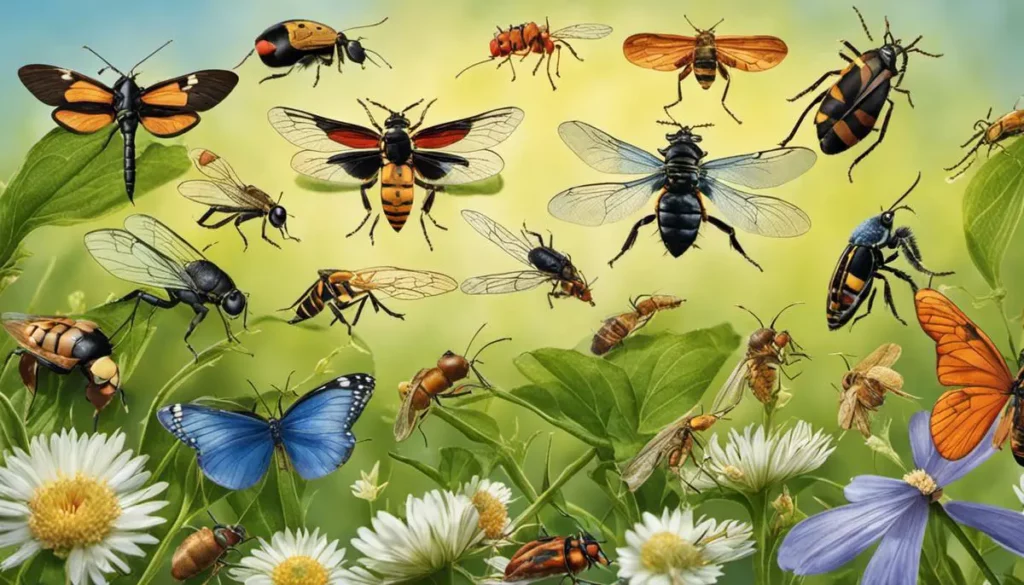When you lay down for a peaceful night’s sleep, the last thing you want is a horde of cockroaches scuttling across your kitchen floor or a thousand tiny termites gnawing at the woodwork.
These are among the nightmare scenarios played out in countless homes across the country as a result of insect infestations. Such infestations can occur for a variety of reasons, from conducive environmental factors to carelessness in food storage.
And once these uninvited guests take up residence in your home, extracting them can be challenging. This article will systematically delve into a wide array of insect infestations, their causes and consequences, and preventive strategies, along with a comparative analysis of DIY and professional pest control approaches.
Types of Insect Infestations
Unwinding the Intricacies of Household Insect Infestations
With the thrill of identifying varying bug types or arthropods vagabonding into the four corners of your homes comes the understanding that these buzzing, crawling, or scuttling freelance guests aren’t always a pleasant sight. Hobbies encompass a broad spectrum, and entomology certainly holds its fascination for some. However, when it becomes a thrilling home adventure tracking insect invasions rather than an outdoor exploration, the excitement might skid a peg or two. This article dives into the common types of insect infestations that entomologists, professionals, or hobbyists could encounter within households, leading to surprising discoveries and potential damage control action plans.
Firstly, termites: every homeowner’s worst fear. These critters, deceptively small and almost invisible, can cause substantial damage to wooden structures. Known as the ‘silent destroyers’, they munch on wood, wallpaper, plastics, and fabric made from plants. Their occupations range roughly from 2,000 to an astounding two million comrades in a single colony! Hence, regular inspections and preventive measures are highly advised when one detects a termite activity.
Ant infestations, a widespread issue in numerous homes, often run a close race with termite invasions. The most common variety found in homes is carpenter ants, which, incidentally, also love chewing through wood. These miscreants can cause similar damage to homes like termites; making sure one can differentiate between the two is vital for effective elimination.
Don’t turn a blind eye to the seemingly harmless little species fluttering around your windows and lights – the moths. Certain species’ larvae, like the clothes moth, have an expensive taste for fabrics, especially wool, fur, silk, and leather. Their silky cocoons are viable indicators of an infestation, and they’re not fond of the spotlight but tend to hide in dark, undisturbed areas.
Furthermore, beetles, primarily powderpost beetles, can conquer hardwood. The larvae tunnel into wooden items, turning the insides into fine, powdered dust. Identifying their existence early becomes imperative to protect wooden furniture and structures from potentially irreversible destruction.
Roaches, feared by most yet fascinating to some, are another common household intruder. Apart from leaving traces like droppings, an oily smell, and skin shedding, they can also spread diseases—a welcome mat for both entomologists and pest control!
Last but not least, if there are parts of your carpet turning threadbare or you find small maggot-like creatures in it, you’re most likely dealing with a carpet beetle infestation. Their larvae feed on wool, silk, leather, pet hair, and even dead insects. The damage they produce can be enormous, considering their tiny size.
Remember, this foray into common household insect infestations isn’t to instill fear but rather to awaken curiosity and a guideline to understand when professional intervention is needed. When life gives you bugs, grab a magnifying glass—but also the number for pest control. It’s all part and parcel of being amateur entomologists in our humble abodes! The world is full of creepy crawlies- some are welcome. Others? Not so much.

Causes and Consequences of Insect Infestations
Let’s dig a little deeper into how these pesky critters can home in on our beloved living quarters. Insects, like all creatures, have their motivations for invading our space, and understanding these motivations is key to preventing potential impacts.
An essential element of insect infestations is the availability of food- they’re always on the lookout for that indulgent banquet! Need we mention the fruit flies attracted to overripe fruit and dirty dishes or the tobacco beetles who get an adrenaline rush from your stash of cigars, dried fruits, and even spices? These minute yet mighty pests will find a way to the food source and multiply before we can say ‘exterminate’!
Also, insects tend to be architectural fanatics, falling for narrow crevices, wall voids, and attics that offer the ideal hide and multiply zones. The intricate networks of the booklice (who devour our beloved books), fire ants, and silverfish are a testament to their construction passion.
Seasonality, too, plays its cards with bug breakouts. Aphids and cluster flies seem to find the warmth and safety of our homes irresistible in winter. Equally, mosquitoes find a fertile breeding ground when our bird baths or yard puddles hold stagnant water in the hotter months.
Let’s switch lanes and take a peek at the aftermath. Clearly, the damage stretches beyond mere annoyance. Health-wise, infamous bed bugs are capable of causing itchy, often allergic reactions, while fleas and ticks are able to spread diseases such as Lyme disease and typhus. On a psychological note, these intrusions may lead to anxiety, disturbed sleep, and stress.
Property damage is another significant factor to reckon with. The big-headed ants, for instance, may not chomp at your wooden structures, but they sure can destroy insulation and electrical wiring. Damage to the home environment also extends to nuisances like pantry pests- Indian meal moths, weevils, and grain beetles that love nothing more than burrowing into your stored goodies and leaving behind a distaste.
The intricate dance with pesky intruders is more than a one-time spray with pest control. Understanding behaviors and motivations alongside potential impacts is central to maintaining an insect-free habitat lovingly called home!

Prevention and Control of Insect Infestations
Onward with our exciting exploration of insect infestations! Having brushed up on widespread pests and their damaging effects, let’s now focus on prevention and control. Don’t fret; it’s not as daunting as it seems. Indeed, with a little know-how, the battle against tiny critters can be won.
Understand that insects abhor cleanliness. Regular cleaning is essential to prevent the buildup of food particles, which attract various insects like ants and cockroaches. Pay attention to corners, under furniture, and hidden spaces that act as perfect homes for these little nuisances. Wipe down countertops and cookware immediately after use, and avoid leaving dirty dishes out overnight. Regularly vacuuming or steam cleaning carpets and upholstery helps eliminate potential breeding spots for pests like fleas and dust mites.
For food storage, stick to glass or metal containers with tight lids to keep out pantry pests. Regularly rotate and keep a close eye on the expiry dates of the food items. Be alert for signs of pests, such as holes in bags or boxes, and discard infected food promptly.
Got a treasure trove of antique furniture? Keep an eye out for pests who love gnawing on wood—like powderpost beetles. Use varnishes or sealants that pests find unpleasant. The same goes for wardrobes storing natural fibers! Clean and vacuum your wardrobes and drawers regularly, as clothes moths love to lay their eggs in rarely disturbed places.
Now, a few words cannot stress enough the importance of timely and regular check-ups for your beloved home. From basements to attics, no corner should be left unattended. Insects like termites or carpenter ants love hidden, hard-to-reach areas. Regular inspections by you or a professional could save you from substantial structural damage!
Battling any insect infestation is a two-front war in your home and your garden. Wondering why your roses look so forlorn? It could be aphids! And that hole-riddled tree bark? Termites! Hence, maintaining a clean, well-pruned yard reduces the chances of a full-fledged attack from the outside.
What about flying insects like mosquitos or flies? Avoid stagnant water around your property. From old tires to bird baths and pet dishes, ensure regular emptying and cleaning. Screens on windows and doors prevent invading winged critters while allowing you to enjoy a fresh breeze.
One might wonder, ‘Are repellants and pesticides part of this battle?’ Yes, but with a caveat: use wisely. Various effective natural, chemical-free repellants are available for different insects, reducing the harmful impact on your health and the environment. And when heavy artillery is needed, professional pest control services can help you choose the least harmful yet effective solutions.
Big picture, preventing and controlling insect infestations might seem tedious, but with some regular checks and maintenance, it becomes part of your everyday routine. Why not turn it into an earth-friendly scavenger hunt, your tiny contribution to maintaining the delicate balance of the ecosystem? After all, even pests play a part in our world’s amazing biodiversity—they need to know their place and avoid ours!

DIY Insect Infestation Solutions Vs. Professional Pest Control Services
When combating pesky intruders such as critters and insects, sometimes a DIY approach is the first line of action. With knowledge and the right tools, it’s possible to transform your home into a pest-free haven.
To successfully manage pest issues, keen observation is the key. Regularly monitoring areas where insects tend to congregate, such as the kitchen and bathrooms, can dampen the chances of a heavy infestation. But you might ask, how do we determine when to brave the battle ourselves and when to wave the white flag for professional help?
Predominantly, tackling small-scale insect infestations can often be successfully accomplished at home. Swift implementation of eco-friendly pest control strategies—using citrus sprays for ants, vinegar for fruit flies, or boric acid for cockroaches—can send an inviting message to these pests that your home is off-limits!
DIY strategies are not only cost-effective, but they can also be fun and interactive, turning otherwise unpleasant tasks into educational family activities! Moreover, when home-based solutions are integrated with routine cleaning measures, the probability of managing pests effectively notably increases.
However, it’s essential to remember that not all pests can be defeated single-handedly. Certain invaders, like bed bugs or extensive rat colonies, require more than commercially available traps or repellants and may need professional handling. Also, it’s critical to mention stinging insects—wasps, bees, and hornets—as professionals better handle their colonies due to the potential threat they pose.
Subsequently, persistent pest problems that return even after employing sustainable DIY methods should be an immediate signal to call in reinforcements. Likewise, be mindful of pest-related health risks. Pest infestations that cause harmful allergic reactions or diseases demand fast professional intervention.
Last but not least, prevention is always better than cure. Preventative measures are our most potent weapon against persistent pests. By maintaining a clean environment, regularly checking our essential furniture and cabinets, and keeping our kitchen crumble-free and our gardens well-kept, we can enjoy a pest-free household.
Let’s remember every home is unique, as are the pests that intrude them. Therefore, it’s crucial to understand the type of invaders you are dealing with and associate the appropriate pest control measures accordingly. While DIY pest-control methods may work wonders in some scenarios, don’t hesitate to call for professional help when the situation escalates. After all, a pest-free home paves the way to a peaceful and healthy mind. So arm yourselves with helpful information and robust determination, and keep your homes safe from unwanted visitors.

Armed with this knowledge, you’ll be better equipped to quickly recognize the signs of an insect infestation and take swift action to correct it. Understanding the environment where various insects thrive and the clues they leave behind can help nip a problem in the bud before it becomes a full-blown infestation. Similarly, comprehending the advantages and disadvantages of DIY and professional pest control measures allows you to make wise choices based on your budget and the severity of the infestation.
Ultimately, managing insect pest control is about being proactive it’s about maintaining a clean, well-ordered home environment; it’s about regular checks and timely intervention; it’s about keeping your sanctuary free of things that creep and crawl.

